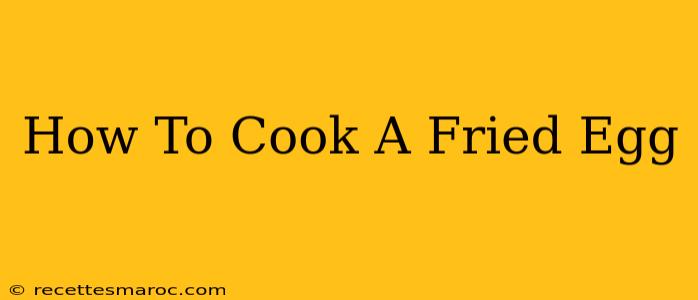So, you want to learn how to cook a fried egg? It might seem simple, but a truly perfect fried egg is a thing of beauty – crispy edges, a runny yolk, and a satisfyingly soft white. This guide will walk you through the process, ensuring you achieve fried egg mastery every time.
Essential Equipment and Ingredients
Before we begin, let's gather everything you'll need:
- Fresh Eggs: The fresher the egg, the better the result. Older eggs tend to have flatter whites.
- Non-stick Frying Pan: A good non-stick pan is crucial for easy cooking and cleanup.
- Butter or Oil: Your choice of fat will impact the flavor and crispness. Butter adds richness, while oil provides a crispier edge. About 1 tablespoon should suffice.
- Spatula: A thin, flexible spatula is perfect for gently flipping the egg (if desired) and serving.
- Salt and Pepper: To taste. Consider adding other seasonings like garlic powder or paprika for extra flavor!
Step-by-Step Instructions for the Perfect Fried Egg
Here's how to cook a fried egg to perfection:
1. Prepare your pan: Place your non-stick frying pan over medium-low heat. Add your chosen fat (butter or oil) and allow it to melt and coat the pan evenly. You'll know it's ready when the butter foams gently or the oil shimmers. Avoid high heat, as this will burn the egg before the white sets.
2. Crack the egg: Carefully crack the egg directly into the pan. Try to keep the yolk intact.
3. Cook the whites: Let the egg cook undisturbed for about 2-3 minutes, or until the whites around the yolk begin to set and turn opaque.
4. Cook the yolk (optional): If you prefer a fully cooked yolk, continue cooking for another 1-2 minutes. For a runny yolk (the most desirable for many!), you can stop here, or even slightly undercook the yolk.
5. Season and serve: Gently slide your spatula under the egg to loosen it from the pan. Season with salt and pepper to taste. Serve immediately on toast, in a sandwich, or as a standalone masterpiece!
Tips for the Perfect Fried Egg
- Low and slow is key: Using low to medium-low heat ensures even cooking and prevents burning.
- Don't overcrowd the pan: Cook one egg at a time for best results.
- Experiment with fats: Try different types of oil or butter to see what flavor profiles you prefer.
- Get creative with toppings: Add your favorite toppings such as cheese, hot sauce, avocado, or chives.
- Practice makes perfect: Don't be discouraged if your first few attempts aren't perfect. Keep practicing, and you'll soon be frying eggs like a pro.
Troubleshooting Common Fried Egg Problems
- Burnt Edges: Reduce the heat.
- Tough Whites: Use lower heat and don't overcook.
- Broken Yolk: Crack the egg gently into a small bowl first, then transfer to the pan.
Mastering the art of the fried egg is a culinary achievement that will impress your friends and family. So grab those eggs and start cooking! You’ve got this!

